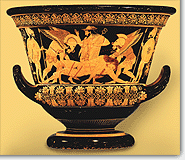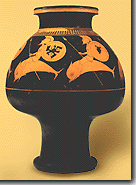









        
| |
| |
The red-figure style is the exact opposite of the black figure one: the background was painted black except for the figures whose outlines had been preliminary sketched. The figures were left in the colour of the clay. Their details were drawn with very thin brushes, even as thin as a single hair. As shown by recent research the relief line of the red-figure style is owed to this method. At the same time the dilution of the slip (to various degrees) allowed the creation of layers of brown or honey-coloured lines. Engraving was scarcely or not used at all and the added colours were remarkably limited. The possibility of depiction of the background -and thus of every element of perspective - was almost impossible. The figures were mainly attributed as light coloured masses over a dark background, exactly as happened with the bas reliefs of the same period. In fact the vase painting imitated many conventions of bas-relief. The volumes of anatomical details were attributed with outlines, as for example in the case of the muscles of the stomach, of the kneecap, of the ankles or of the hook that conventionally represented the clavicle bone. |  |
Paseas must be added to the painters of bilingual vases that we have already mentioned (Andokides painter, Psiax), a painter who is characterised for the accuracy of the figures and their relatively large heads. |
 |
However, the first real group of artists that we know in the history of western art are known as Pioneers. Their work is dated in the last twenty years of the |
|
| |
|
Note: Click on picture for short description. | |